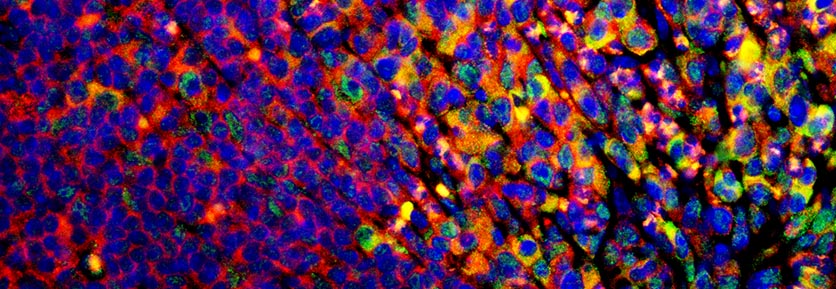Novel injectable therapy shows promise in treating Crohn’s disease
A team of Simpson Querrey Institute (SQI) researchers led by Arun Sharma has demonstrated that a direct injection of anti-inflammatory peptide amphiphiles (PAs) into intestinal lesions can reduce lesion size and inflammation in an animal model of Crohn’s disease, a chronic condition that is notoriously difficult to treat.

Depending on disease severity, current treatment options for inflammatory bowel diseases (IBDs) range from oral medications to highly invasive surgery to remove affected tissue. However, patients often become refractory to treatment over time, leaving surgery as the final option. For Crohn’s disease specifically, approximately 70 percent of patients undergo surgery within their lifetimes, and 60 percent of those individuals require repeat operations within 10 years — significantly impacting their quality of life and contributing to billions of dollars in medical costs each year in the U.S. alone.
Given these challenges, novel treatments for Crohn’s disease and other IBDs such as ulcerative colitis could have significant impact. In their study published Feb. 5 in Advanced Therapeutics, the Sharma Lab developed and effectively utilized anti-inflammatory PAs in a mouse model of Crohn’s disease-like ileitis.
PAs are a technology that was pioneered by SQI director and study coauthor Samuel Stupp, a longtime collaborator of the Sharma Lab. PAs can self-assemble into nanofibers that present biologically active molecules on their surfaces to initiate targeted physiological responses in the body.
“We know that PAs are biodegradable and they seem relatively safe in the body from other studies that Sam’s group has reported, so we feel that this is a good platform to move into the clinic,” said Sharma, Research Associate Professor of Urology and Biomedical Engineering at Northwestern. “We’ve used these anti-inflammatory PAs in the past in a urinary bladder tissue regeneration setting, so the goal of the current study was to determine whether or not these really potent anti-inflammatory PAs could knock back the inflammatory environment in a mouse model of Crohn’s disease-like ileitis.”
Indeed, a direct injection of the PAs into small intestinal lesions in mice resulted in statistically significant — and reproducible — reductions in lesion size and various cellular and protein markers of inflammation. After treatment, the researchers also saw an uptick in M2 macrophages, a pro-regenerative and anti-inflammatory subset of white blood cells, accompanied by a decrease in pro-inflammatory M1 macrophages.

These observations provided further evidence that the PAs offer the potential to tune the body’s immune system to positively address inflammation.
“Given the number of people affected by IBDs and the challenges of managing a chronic condition, our hope is to contribute to the expansion of treatment options that could improve quality of life,” said Natalie Fuller, a research associate in the Sharma laboratory and co-first author of the paper. “With the promising results we’ve seen in addressing chronic intestinal inflammation in this model, we look forward to further studies exploring the potential of this treatment platform.”
Sharma said the anti-inflammatory PAs could conceivably be used in “almost any situation when you have protracted inflammation,” resulting in a variety of potential applications for cardiovascular disease, spinal cord injury and other conditions.

“Our group has now shown that these anti-inflammatory PAs are useful in tissue regeneration and alleviating major inflammatory responses,” said Matthew Bury, a research associate in the Sharma laboratory and co-first author of the paper. “Peptide amphiphiles have incredible customizable features, and I am excited to see how they can be applied in other areas as an effective form of treatment.”
In the context of IBD, the group is now testing a modified form of the PAs that can be delivered noninvasively through intravenous injections. Sharma said they are also considering encapsulating the anti-inflammatory PAs so they can be swallowed, or delivering them via endoscopy.
Another possibility to explore is whether the therapy could be used in conjunction with other treatments to achieve an additive or synergistic effect.
“From what we’ve observed in this particular model, it could act as a standalone therapy or it could be combined with other currently FDA-approved treatment regimens for Crohn’s disease,” Sharma said. “It could potentially knock down the inflammation level in the gut to undetectable levels for long periods of time.”
The study was supported by the Hartwell Foundation, SQI’s Center for Regenerative Nanomedicine and the Stanley Manne Children's Research Institute at the Ann & Robert H. Lurie Children’s Hospital of Chicago. The PAs used in the study were prepared in SQI’s Peptide Synthesis Core Facility.

Epifluorescent image of intestinal tissue-derived cells stained with inflammatory markers in an animal model of Crohn’s disease-like ileitis. (Photo courtesy of the Sharma Lab)
